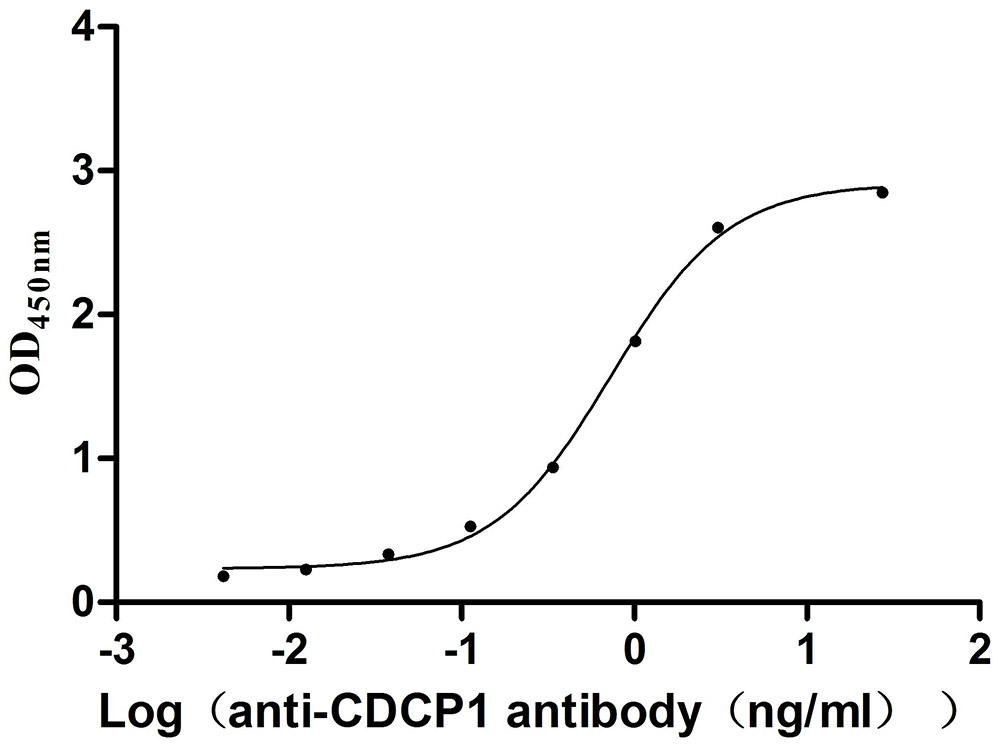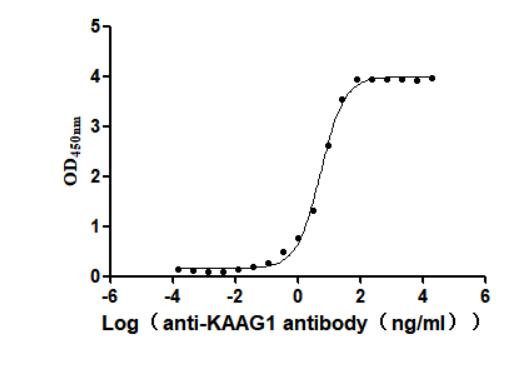Recombinant Human Lactosylceramide alpha-2,3-sialyltransferase (ST3GAL5), partial
-
中文名称:人ST3GAL5重组蛋白
-
货号:CSB-YP890769HU
-
规格:
-
来源:Yeast
-
其他:
-
中文名称:人ST3GAL5重组蛋白
-
货号:CSB-EP890769HU-B
-
规格:
-
来源:E.coli
-
共轭:Avi-tag Biotinylated
E. coli biotin ligase (BirA) is highly specific in covalently attaching biotin to the 15 amino acid AviTag peptide. This recombinant protein was biotinylated in vivo by AviTag-BirA technology, which method is BriA catalyzes amide linkage between the biotin and the specific lysine of the AviTag.
-
其他:
-
中文名称:人ST3GAL5重组蛋白
-
货号:CSB-BP890769HU
-
规格:
-
来源:Baculovirus
-
其他:
-
中文名称:人ST3GAL5重组蛋白
-
货号:CSB-MP890769HU
-
规格:
-
来源:Mammalian cell
-
其他:
产品详情
-
纯度:>85% (SDS-PAGE)
-
基因名:ST3GAL5
-
Uniprot No.:
-
别名:3-sialyltransferase; CMP-NeuAc:lactosylceramide alpha-2; CMP-NeuAc:lactosylceramide alpha-2,3-sialyltransferase; EC 2.4.99.9; Ganglioside GM3 synthase; Lactosylceramide alpha-2,3-sialyltransferase; Sialyltransferase 9; SIAT9; SIAT9_HUMAN; SIATGM3S; ST3 beta-galactoside alpha-2,3-sialyltransferase 5; ST3GAL; ST3Gal V; ST3GAL5; ST3GalV
-
种属:Homo sapiens (Human)
-
蛋白长度:Partial
-
蛋白标签:Tag type will be determined during the manufacturing process.
The tag type will be determined during production process. If you have specified tag type, please tell us and we will develop the specified tag preferentially. -
产品提供形式:Lyophilized powder
Note: We will preferentially ship the format that we have in stock, however, if you have any special requirement for the format, please remark your requirement when placing the order, we will prepare according to your demand. -
复溶:We recommend that this vial be briefly centrifuged prior to opening to bring the contents to the bottom. Please reconstitute protein in deionized sterile water to a concentration of 0.1-1.0 mg/mL.We recommend to add 5-50% of glycerol (final concentration) and aliquot for long-term storage at -20℃/-80℃. Our default final concentration of glycerol is 50%. Customers could use it as reference.
-
储存条件:Store at -20°C/-80°C upon receipt, aliquoting is necessary for mutiple use. Avoid repeated freeze-thaw cycles.
-
保质期:The shelf life is related to many factors, storage state, buffer ingredients, storage temperature and the stability of the protein itself.
Generally, the shelf life of liquid form is 6 months at -20°C/-80°C. The shelf life of lyophilized form is 12 months at -20°C/-80°C. -
货期:Delivery time may differ from different purchasing way or location, please kindly consult your local distributors for specific delivery time.Note: All of our proteins are default shipped with normal blue ice packs, if you request to ship with dry ice, please communicate with us in advance and extra fees will be charged.
-
注意事项:Repeated freezing and thawing is not recommended. Store working aliquots at 4°C for up to one week.
-
Datasheet :Please contact us to get it.
相关产品
靶点详情
-
功能:Transfers the sialyl group (N-acetyl-alpha-neuraminyl or NeuAc) from CMP-NeuAc to the non-reducing terminal galactose (Gal) of glycosphingolipids forming gangliosides (important molecules involved in the regulation of multiple cellular processes, including cell proliferation and differentiation, apoptosis, embryogenesis, development, and oncogenesis). Mainly involved in the biosynthesis of ganglioside GM3 but can also use different glycolipids as substrate acceptors such as D-galactosylceramide (GalCer), asialo-GM2 (GA2) and asialo-GM1 (GA1), although less preferentially than beta-D-Gal-(1->4)-beta-D-Glc-(1<->1)-Cer (LacCer).
-
基因功能参考文献:
- While no differences in clinical characteristics were detected in patients possessing the functional promoter haplotypes of ST3GAL5, exophthalmic values were significantly lower in patients with the ST8SIA1 haplotype, which showed a significant increase in promoter activity PMID: 29047240
- These cases broaden the phenotypic and genetic spectrum of GM3 synthase deficiency due to ST3GAL5 variants. Patients with intellectual disability or furthermore presenting with Rett-like phenotype should be suspected of GM3 synthase deficiency, a disorder of ganglioside biosynthesis. PMID: 27232954
- Data suggest that ganglioside glycosyltransferases ST3GAL5, ST8SIA1, and B4GALNT1 are S-acylated at conserved cysteine residues located close to cytoplasmic border of their transmembrane domains; ST3Gal-II is acylated at conserved cysteine residue in N-terminal cytoplasmic tail; for B4GALNT1 and ST3Gal-II, dimer formation controls their S-acylation status. PMID: 28698248
- Studied the miRNA expression in human hepatocellular carcinoma cell lines; 13 differentially expressed miRNAs were identified between MHCC97-H and MHCC97-L cells; and the same results were found in clinical samples. Found that ST3GAL5 was the direct target of miR-26a, miR-548l and miR-34a. PMID: 28218742
- Serum deprivation triggers upregulation of hST3Gal V gene expression through Runx2 activation by BMP signaling in MG-63 cells. PMID: 26729095
- Whole-exome sequencing of patients with salt and pepper syndrome shows a homozygous c.994G>A transition (p.E332K) in the ST3GAL5 gene. PMID: 24026681
- GM3 synthase deficiency, responsible for early-onset epilepsy syndrome, leads to a secondary respiratory chain dysfunction. PMID: 22990144
- Data demonstrate that valproic acid (VPA) transcriptionally regulates human GM3 synthase (hST3Gal V), which catalyzes ganglioside GM3 biosynthesis in ARPE-19 human retinal pigment epithelial cells. PMID: 21699754
- GM3 exhibits the potential to regulate the allosteric structural transition from inactive to a signaling EGFR dimer, by preventing the autophosphorylation of the intracellular kinase domain in response to ligand binding PMID: 21571640
- In vivo expression of the transcript gives rise to two human ST3Gal-V isoforms with distinct characteristics. PMID: 20219466
- ST6Gal I and ST3Gal V were positively correlated with the high risk of pediatric acute leukemia. PMID: 19709745
- GM3 synthase overexpression results in reduced cell motility and in caveolin-1 upregulation in human ovarian carcinoma cells PMID: 19759399
- GM3 synthase mRNA levels were significantly higher in differentiated human monocyte-derived macrophages compared to monocytes and in atherosclerotic aorta compared to normal aorta PMID: 19415461
- isolation and characterization of the promoter region PMID: 12393190
- enhanced expression of GM3 synthase through protein kinase C /extracellular regulated kinases-dependent cAMP-responsive element binding protein activation by phorbol 12-myristate 13-acetate is associated with the differentiation of HL-60 cells PMID: 15385432
- ). We sequenced genes in the region and identified a nonsense mutation in SIAT9, which is predicted to result in the premature termination of the GM3 synthase enzyme (also called lactosylceramide alpha-2,3 sialyltransferase). PMID: 15502825
- These results are the first demonstration of the existence of a new isoform of human GM3 synthase, which could play an important role during HL60 cell differentiation. PMID: 16934889
- GM3 synthase point mutation almost completely depletes human fibroblast cellular gangliosides, dampens membrane EGFR activation, and modulates related critical cell functions such as proliferation and migration PMID: 18480157
- Ganglioside GM3 inhibits VEGF/VEGFR-2-mediated angiogenesis. Direct interaction of GM3 with VEGFR-2 is reported. PMID: 18974200
显示更多
收起更多
-
相关疾病:Salt and pepper developmental regression syndrome (SPDRS)
-
亚细胞定位:Golgi apparatus membrane; Single-pass type II membrane protein.
-
蛋白家族:Glycosyltransferase 29 family
-
组织特异性:Ubiquitous. High expression in brain, skeletal muscle, placenta, and testis. mRNA widely distributed in human brain, but slightly elevated expression was observed in the cerebral cortex, temporal lobe, and putamen.
-
数据库链接:
HGNC: 10872
OMIM: 604402
KEGG: hsa:8869
STRING: 9606.ENSP00000366549
UniGene: Hs.415117
Most popular with customers
-
Recombinant Human Claudin-6 (CLDN6)-VLPs (Active)
Express system: Mammalian cell
Species: Homo sapiens (Human)
-
Recombinant Human Trophoblast glycoprotein (TPBG), partial (Active)
Express system: Mammalian cell
Species: Homo sapiens (Human)
-
Recombinant Human Carcinoembryonic antigen-related cell adhesion molecule 6 (CEACAM6) (Active)
Express system: Mammalian cell
Species: Homo sapiens (Human)
-
Recombinant Mouse CUB domain-containing protein 1 (Cdcp1), partial (Active)
Express system: Mammalian cell
Species: Mus musculus (Mouse)
-
Recombinant Human Cadherin-6(CDH6),partial (Active)
Express system: Mammalian cell
Species: Homo sapiens (Human)
-
Recombinant Human Kidney-associated antigen 1(KAAG1) (Active)
Express system: Baculovirus
Species: Homo sapiens (Human)
-
Recombinant Human C-C chemokine receptor type 5 (CCR5)-VLPs (Active)
Express system: Mammalian cell
Species: Homo sapiens (Human)


-AC1.jpg)
















